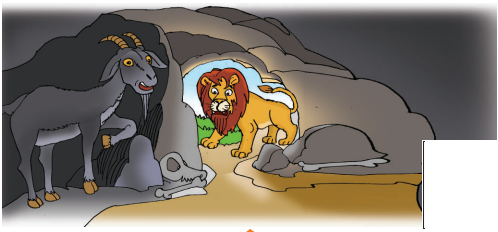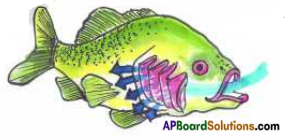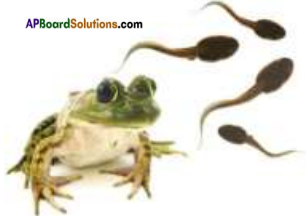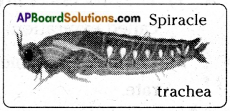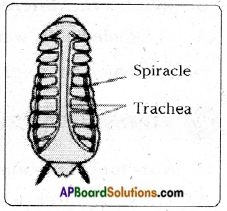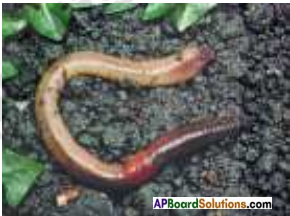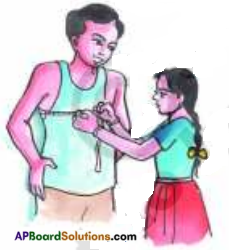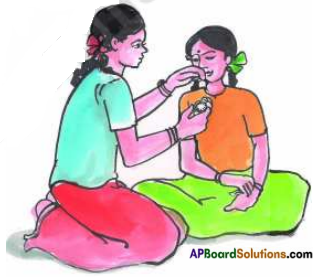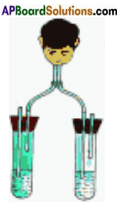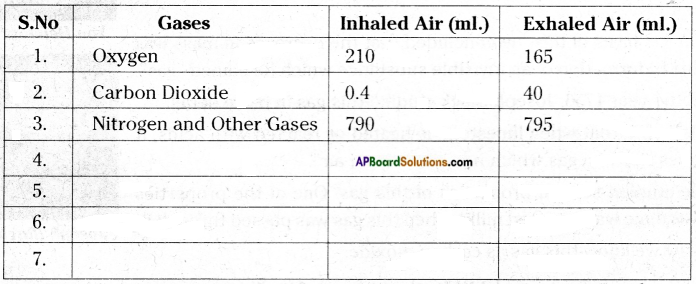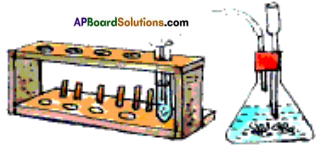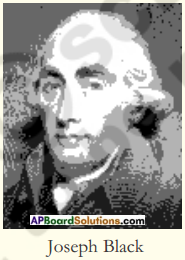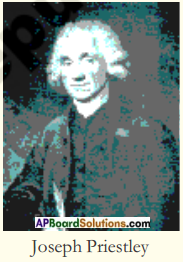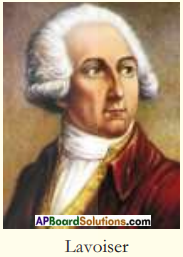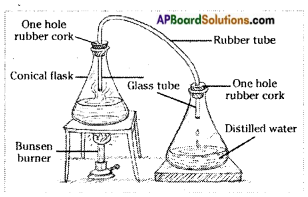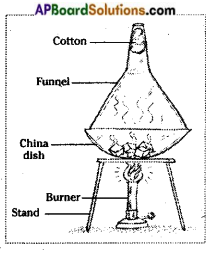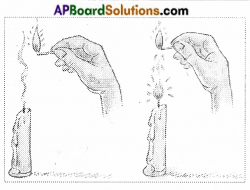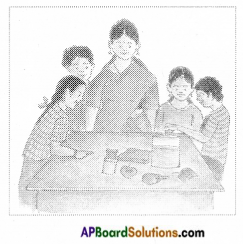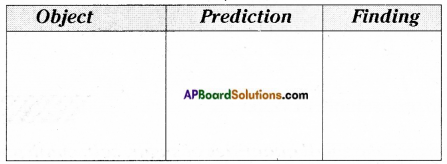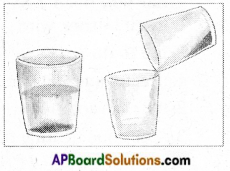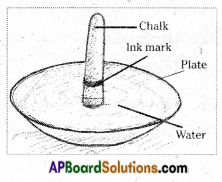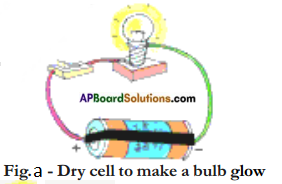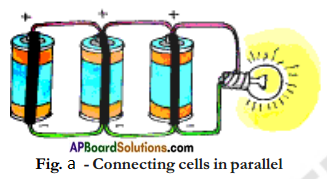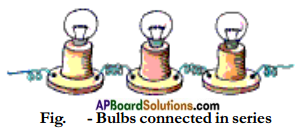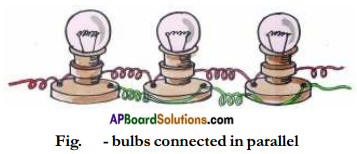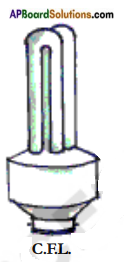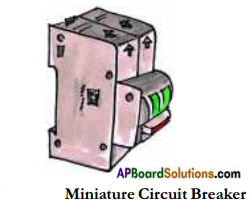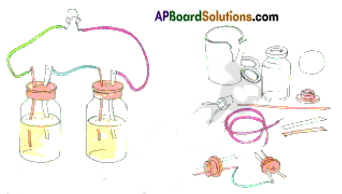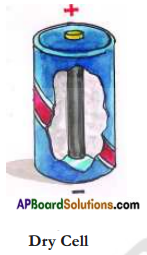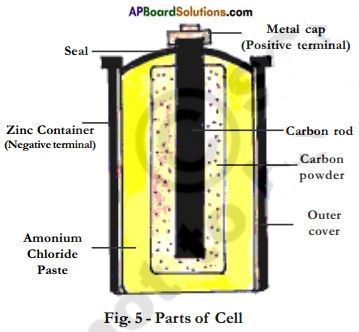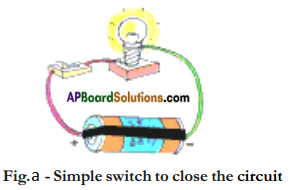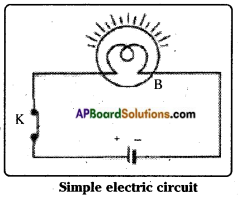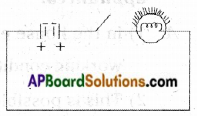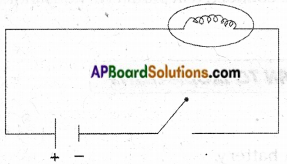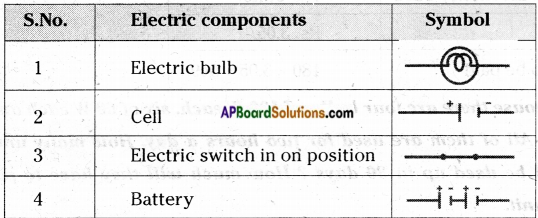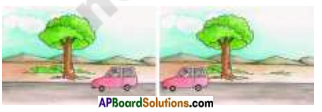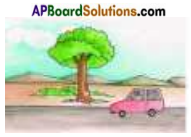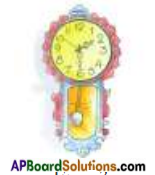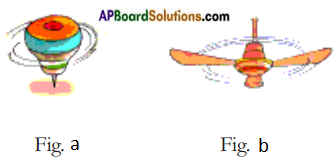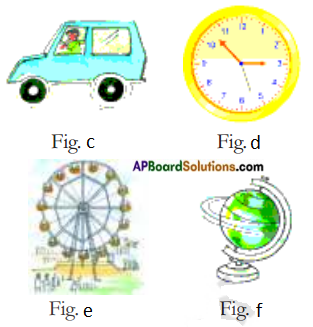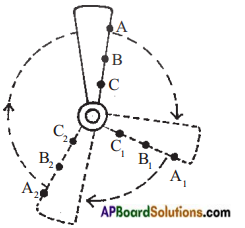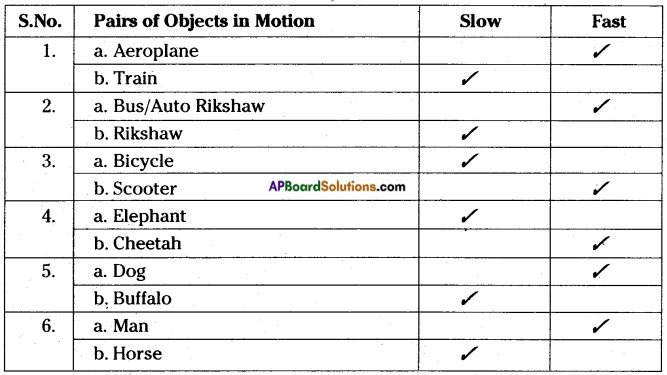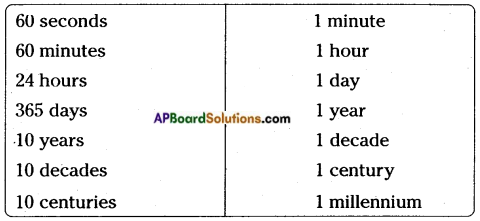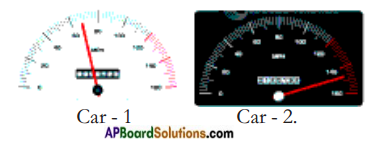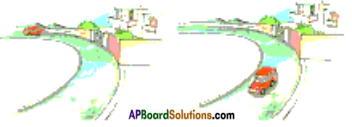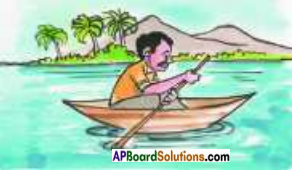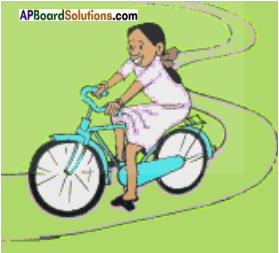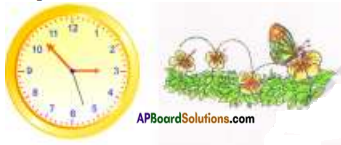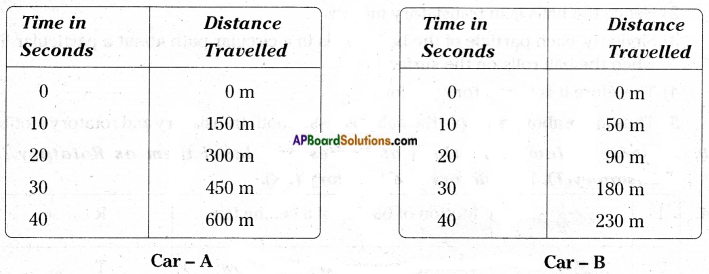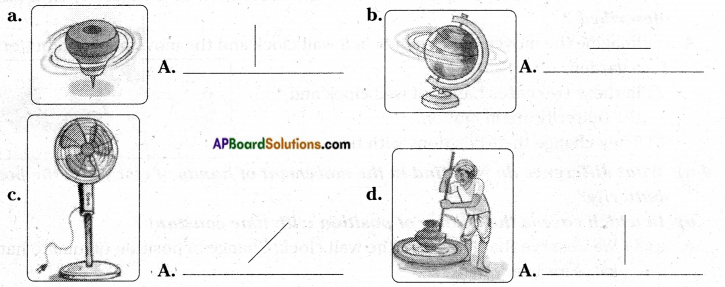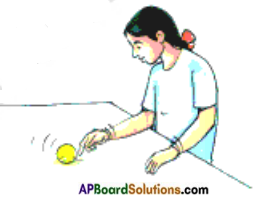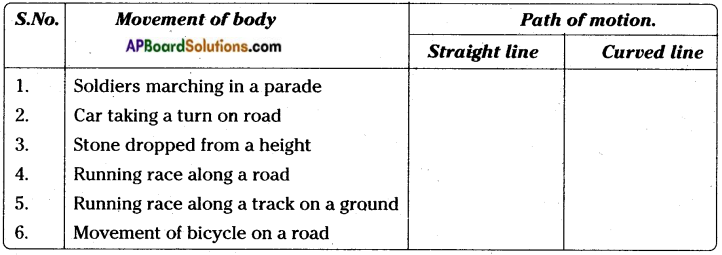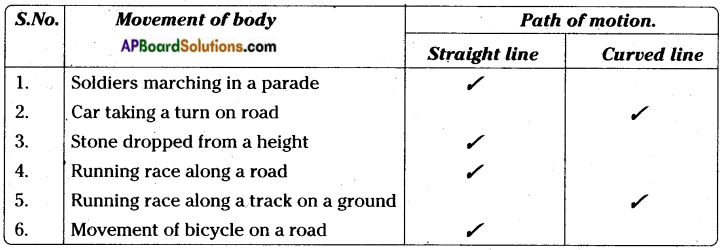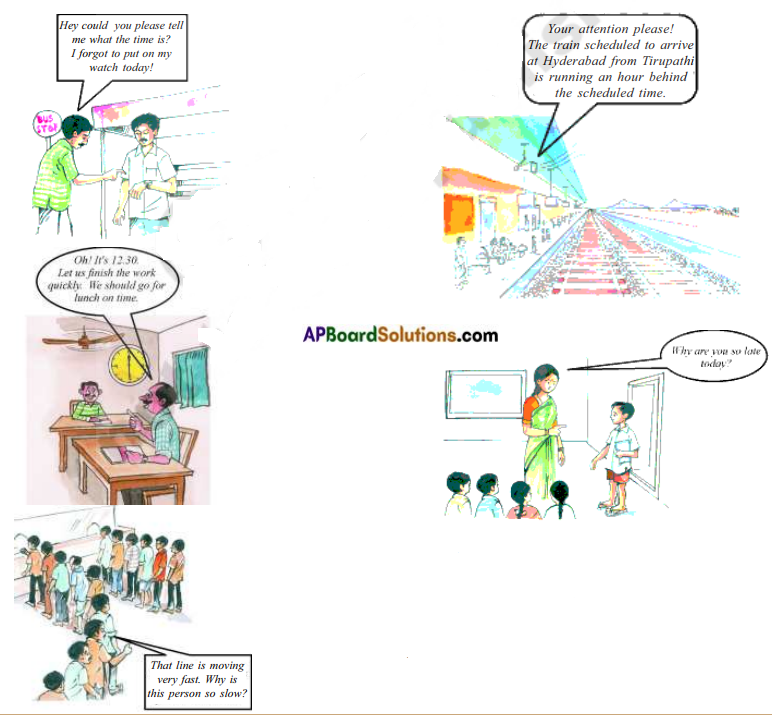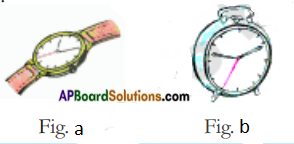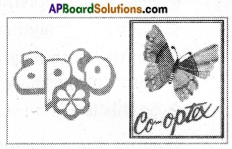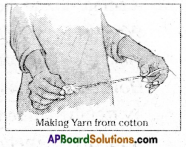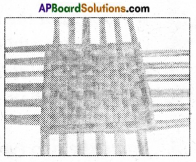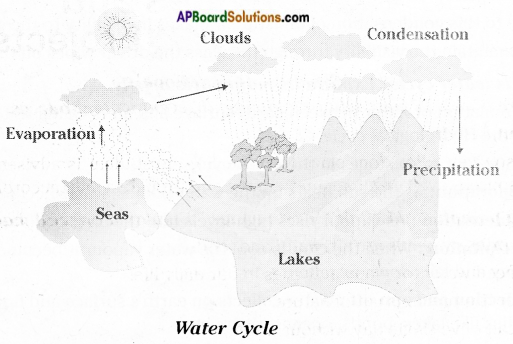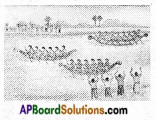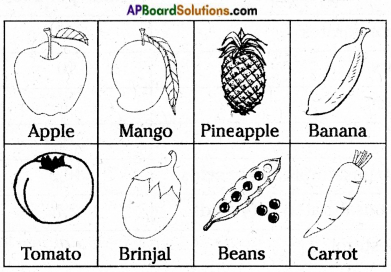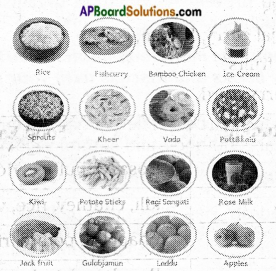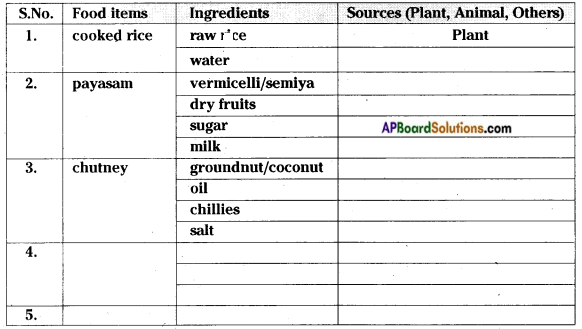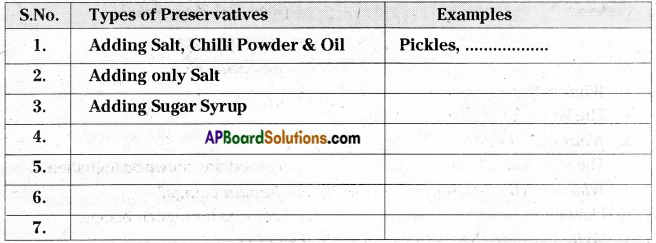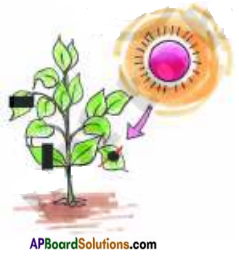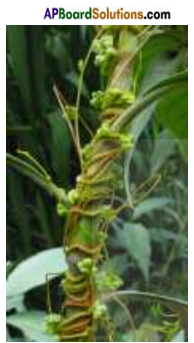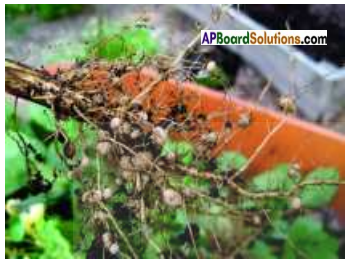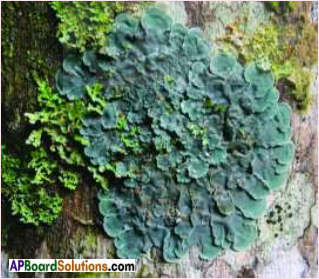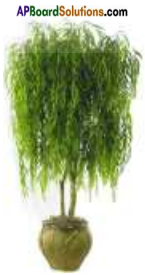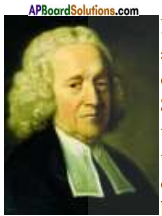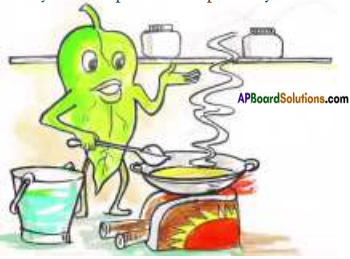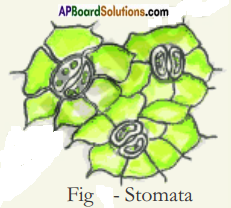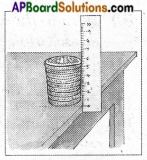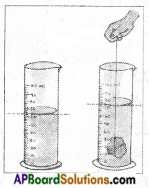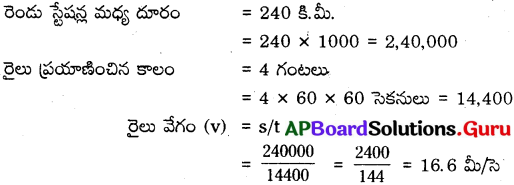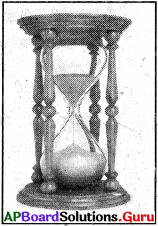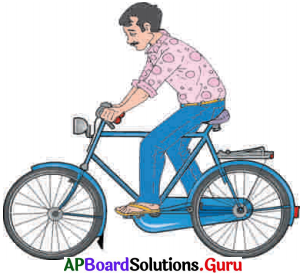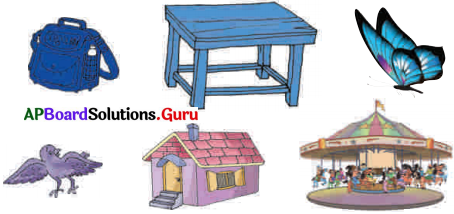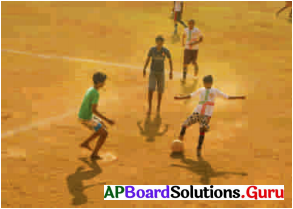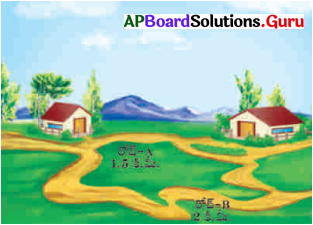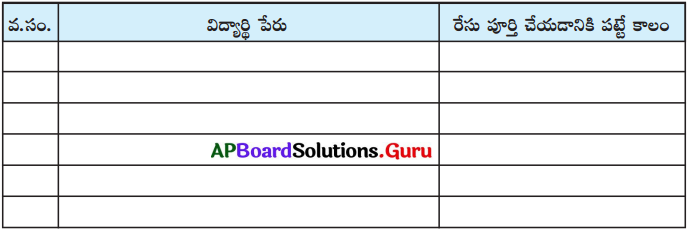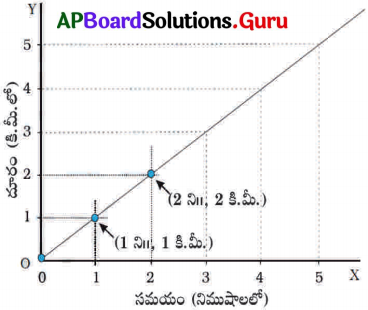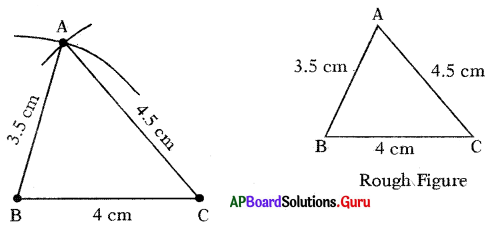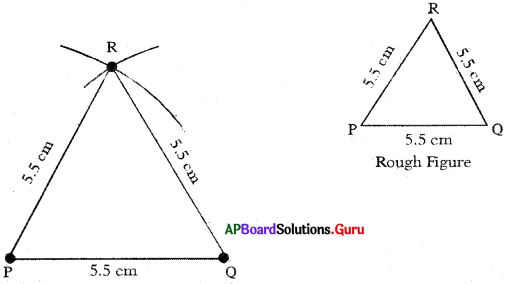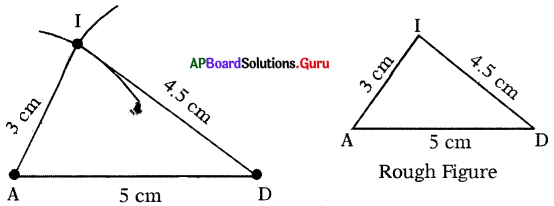Andhra Pradesh AP Board 3rd Class Telugu Solutions 6th Lesson మేమే మేక పిల్ల Textbook Exercise Questions and Answers.
AP State Syllabus 3rd Class Telugu Solutions Chapter 6 మేమే మేక పిల్ల
చిత్రం చూడండి. ఆలోచించి మాట్లాడండి.
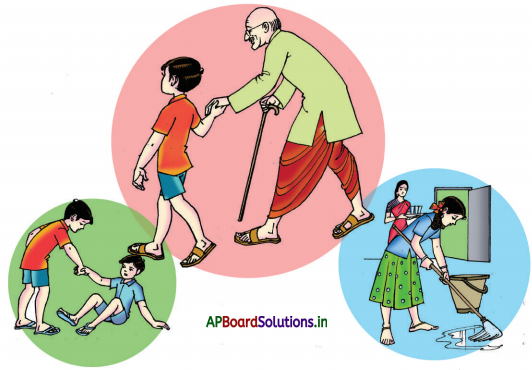
ప్రశ్నలకు జవాబులు చెప్పండి.
ప్రశ్న 1.
చిత్రంలోని సన్నివేశాల గురించి మాట్లాడండి ?
జవాబు:
మొదటి చిత్రంలో – పై నున్న పెద్ద చిత్రంలో ఒక పిల్లవాడు – ఒక పెద్దాయనను చేయి పుచ్చుకుని నడిపిస్తున్నాడు. ఇది పెద్దల పట్ల గౌరవం, మానవత్వం.
క్రింద ఉన్న చిత్రంలో – కింద పడిన పిల్లాడిని మరొక పిల్లాడు చేయందించి సహాయం చేస్తున్నాడు. ఇది తోటి వారి పట్ల ఉండాల్సిన స్నేహభావం, మానవత్వం.
మరొక చిత్రంలో – నేల మీద నీళ్ళను తుడిచి ఇంటిని శుభ్రం చేస్తున్నది. ఒక చిన్నారి. ఇది ఇంటి పట్ల ఉండాల్సిన జాగ్రత్త. ఉండవలసిన మంచి లక్షణాలలో పరిశుభ్రత ఒకటి.
ప్రశ్న 2.
చిత్రంలో ఎవరెవరు ఏం చేస్తున్నారు ?
జవాబు:
చిన్నతనం నుండే సామాజిక సృహ కలిగి, సేవాధర్మంతో మెలిగే విధానం ఈ మూడు చిత్రాలలో కనిపిస్తున్నది. నడవలేని పెద్దాయనకు – చేయి పుచ్చుకుని నడిపించడం, కింద పడిన తోటి బాలుడికి చేయందించి లేపటం, ఎవరికీ ఇబ్బంది కలగకుండా కింద పడిన నీటిని వెంటనే శుభ్రం చేయడం అనే పనులు చేస్తున్నారు చిన్నారులు.
![]()
ప్రశ్న 3.
మీ తోటి పిల్లలతో మీరు ఎలా ఉంటారు?
జవాబు:
నాతోటి పిల్లలతో స్నేహభావంతో ఉంటాను. ఇచ్చి పుచ్చుకునే గుణం కలిగి ఉంటాను. సహాయకారిగా ఉంటాను. మంచి మాట కలిగి ఉంటాను. అందరూ ఇష్టపడే ప్రవర్తన, గుణాలు కలిగి ఉంటాను.
పిల్లలూ! పై చిత్రం నుండి మీరు రాయగలిగినన్ని పదాలు రాయండి:
జవాబు:
- పెద్దాయన, తాతగారు
- చేతి కర్ర
- కాళ్ళకు చెప్పులు
- చిన్న పిల్లవాడు
- చిన్న పిల్ల
- తుడుపు కర్ర
- నీరు
- నీళ్ళ లోటాలు
- బకెట్
- తలుపు
ఇవి చేయండి
వినడం – ఆలోచించి మాట్లాడటం
ప్రశ్న 1.
పాఠంలోని చిత్రాన్ని చూడండి. ఎవరెవరున్నారో! ఏం చేస్తున్నారో చెప్పండి.
జవాబు:
మొదటి చిత్రంలో – ఏరు, ఆకులతో ఊగిపోతున్న కొమ్మ, మేమే (మేమే)
రెండవ చిత్రంలో – కట్టెలతో మండుతున్న మంట, మేమే
మూడవ చిత్రంలో – చెట్టు చుట్టుకున్న ముళ్ళ కంచె, గాలి, మేమే
నాల్గవ చిత్రంలో – వంటవాడు, మేమే ఉన్నారు.
వీళ్ళందరూ ఢిల్లీ వెళ్తున్న మేమేను సాయం కోరుతున్నారు. మేమే వంటవాడిని సాయం కోరింది.
![]()
ప్రశ్న 2.
మేకపిల్లకు ఎవరెవరెదురయ్యారో, ఏమిని అడిగారో చెప్పండి.
జవాబు:
- మేకపిల్లకు మొదట ప్రవహిస్తున్న ఏరు ఎదురైంది. దానికి అడ్డంగా ఒక కొమ్మ పడి ఉంది. ఆ ఏరు మేక పిల్లతో…… మేక పిల్లా….. మేకపిల్లా! కొమ్మ నాకు బరువుగా ఉంది. దీని ఆకులన్నీ తినమని కోరింది.
- తోవలో మంట కనిపించి “ మేకపిల్లా…. మేకపిల్లా…! నేను ఆరిపోతున్నాను, కొంచెం నాలుగు పుల్లలు ఎగదోయమ్మా ! అని అడిగింది.
- దారిలో యింకొంచెం ముందు కెళ్ళాక చెట్టుకు ఆనుకుని చల్లగా వీచె ‘గాలి’ ఎదురై…. మేకపిల్లా!… మేకపిల్లా!…. ఈ చెట్టూ చుట్టి ఉన్న ముళ్ళకంచెను జరపవా! గుచ్చు కుంటున్నాయి. అని కోరింది.
ప్రశ్న 3.
మేకపిల్లకు వంటవాడు కాకుండా రాజు ఎదురయితే ఏమి జరిగి ఉండేదో ఊహించి చెప్పండి.
జవాబు:
మేకకు రాజును చూసిన ఆనందం కలిగింది. రాజుగారు ముచ్చటపడి మేకపిల్లను తనతో పాటు తీసికెళ్ళి వంటవాడికి ఇచ్చేవాడు. వంటవాడు తనపని తాను పూర్తి చేసేవాడు. కొన్ని జీవితాలింతే……. “తనకు మాలిన ఆశలు అనర్ధదాయకాలు” ఎవరు ఎక్కడ ఉండాలో అక్కడే ఉండాలి – అప్పుడే క్షేమం. ఇది సృష్టి ధర్మం .
![]()
ప్రశ్న 4.
మీరు మేకపిల్ల స్థానంలో ఉంటే ఏం చేసేవారో చెప్పండి?
జవాబు:
1వ జవాబు : అమ్మమాట వింటాను. అమ్మ చెప్పింది చేస్తాను. అమ్మకు చెప్పకుండా ఏ పని చేయను. ఆపదలను కొని తెచ్చుకోను.
2వ జవాబు : జీవితంలో ఎప్పుడూ! ఎక్కడ ఎవరితో అవసరం ఏర్పడుతుందో తెలియదు కనుక- దారిలో ఎదురైన గాలికి, నిప్పుకు, నీటికి సాయం చేస్తాను. ఆపదలో వాటి సాయాన్ని పొంది బయటపడతాను.
చదవడం – వ్యక్త పరచడం
అ) కింది మాటలు ఎవరు ఎవరితో అన్నారో పాఠంలో గుర్తించి రాయండి.
ప్రశ్న 1.
“అమ్మా నాకు తీరిక లేదు. ఢిల్లీకి పోవాలి, రాజును చూడాలి”
జవాబు:
(మేక) “మే మే” – ఏరుతో పలికినది.
ప్రశ్న 2.
” కొంచెం నాలుగు పుల్లలు ఏగదోయమ్మా”
జవాబు:
మంట – మేమేతో పలికినది.
ప్రశ్న 3.
“ఓహూ అలాగా, నేను రాజు దగ్గరే ఉంటా. నాతోరా చూపిస్తా” .
జవాబు:
వంటవాడు మేమేతో పలికాడు.
ప్రశ్న 4.
“చూశావా మరి. నీవు ఎవరికీ సాయం చేయలేదు. మరి నీకెవరు సాయం చేస్తారు?”
జవాబు:
గాలి – మేమేతో పలికినది.
ఆ) కింది పేరాను చదవండి. కింద ఇచ్చిన ప్రశ్నలకు జవాబులు రాయండి.
అనగనగా ఒక కూరగాయల తోట. ఆ తోటలోని కూరగాయలకు పక్షుల్లా ఎగరాలని కోరిక. వనదేవత వరంతో వాటికి రెక్కలు వచ్చాయి. కూరగాయలు ఎగరటం ప్రారంభించాయి. దొండ, కాకర, మిరప హుషారుగా ఎగిరాయి. సొరకాయ, గుమ్మడి కాయలు ఎగరలేక ఆయాస పడుతున్నాయి. క్యారెట్టు, ముల్లంగి, బెండ చక్కర్లు కొడుతూ ఎగురుతున్నాయి.

అంతలో ఒక పక్షుల గుంపు కూరగాయల పై దాడి చేసింది. పక్షులు పొడుస్తుంటే తప్పించుకోవడానికి కూరగాయలు – నానా తిప్పలు పడ్డాయి. చివరకి ఎలాగోలా తప్పించుకోవడానికి తోటలోకి చేరాయి. వనదేవతను ప్రార్థించి తమకు రెక్కలు వద్దన్నాయి. తిరిగి వాటి యథాస్థానానికి చేరిపోయాయి.
ప్రశ్న 1.
పై పేరాలో ఉన్న కూరగాయల పేర్లు రాయండి.
జవాబు:
దొండకాయ, కాకర, మిరప, సొరకాయ, గుమ్మడి, క్యారెట్టు, ముల్లంగి, బెండ.
![]()
ప్రశ్న 2.
కూరగాయలకు కలిగిన కోరిక ఏమిటి?
జవాబు:
కూరగాయలకు పక్షుల్లా ఎగరాలని కోరిక. కలగింది.
ప్రశ్న 3.
కూరగాయలు చివరకు వనదేవతను ఏమిని ప్రార్థించాయి?
జవాబు:
తమకు రెక్కలు వద్దని ప్రార్థించాయి.
ప్రశ్న 4.
పక్షులు కూరగాయలను ఏమి చేశాయి?
జవాబు:
పక్షులు కూరగాయల పై దాడి చేశాయి. పొడిచి పొడిచి తిప్పలు పెట్టాయి.
ఇ) అ- అభ్యాసంలో ఇచ్చిన పేరా ఆధారంగా కింది వాక్యాలలోని ఖాళీలను పూరించండి.
ప్రశ్న 1.
………………………. వరంతో కూరగాయలకు రెక్కలు వచ్చాయి.
జవాబు:
వనదేవత
ప్రశ్న 2.
…………………….. ఎగరలేక ఆయాసపడ్డాయి.
జవాబు:
సొరకాయ, గుమ్మడికాయ
![]()
ప్రశ్న 3.
కూరగాయల ………………………. గుంపు దాడి చేసింది.
జవాబు:
పక్షులు
ప్రశ్న 4.
కూరగాయలు తప్పించుకొని ……………………. లోకి చేరాయి.
జవాబు:
తోట
పదజాలం
అ) ముందు పాఠంలో ‘వికటకవి’ కథను చదివారు కదా! ‘వికటకవి’ పదం ఎటునుండి చదివినా ఒకేలా ఉంటుంది. వీటిని భ్రమక పదాలు అని అంటారు. కింద భ్రమక పదాలను చదవండి. అలాంటివి మరికొన్ని మీరు రాయండి.
ఉదా :
జలజ
మిసిమి
ముత్యము
కిటికి
జవాబు:
ఫులుపు
కనుకు
విరివి
కలక
కులుకు
వారెవా
ఆ) కింది ఆధారాలతో గళ్ళమ పూరించి మాటలు తయారు చేయండి.
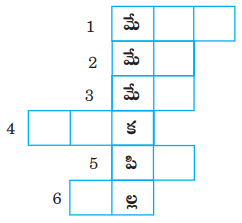
![]()
- గోడకు కొట్టేవి ( )
- పశువులకు వేసేది ( )
- భవనానికి మరో పేరు ( )
- పొలం దున్నడానికి ఉపయోగించేది ( )
- పక్షిని ఇలా కూడా పిలుస్తారు ( )
- చెక్కతో చేసేది ( )
జవాబు:
- గోడకు కొట్టేవి ( మేకులు )
- పశువులకు వేసేది ( మేత )
- భవనానికి మరో పేరు ( మేడ )
- పొలం దున్నడానికి ఉపయోగించేది ( అరక )
- పక్షిని ఇలా కూడా పిలుస్తారు ( పికం )
- చెక్కతో చేసేది ( బల్ల)
స్వీయరచన
అ) కింది ప్రశ్నలకు సొంత మాటల్లో జవాబులు రాయండి.
ప్రశ్న 1.
పాఠం ఆధారంగా మేకపిల్లకు ఎదురైన సంఘటనల గురించి రాయండి.
జవాబు:
‘ఢిల్లీ వెళదాం- రాజును చూద్దాం’ అని పాడుకుంటూ పరిగెత్తుతున్న మేకపిల్లకు దారి మధ్యలో ఒక ఏరు ఎదురైంది. ఆ ఏరు తనకు అడ్డంగా పడి ఉన్న కొమ్మకున్న ఆకులను తినమని అడిగింది మేకపిల్లను. అమ్మో! నాకు తీరిక లేదు ఢిల్లీ పోవాలి రాజును చూడాలి అని పరిగెత్తుతున్న మేకపిల్లకు తోవలో ఒక మంట ఎదురైంది. ‘నేను ఆరిపోతున్నాను’ ‘కొంచెం నాలుగు పుల్లలు ఎగదోయమ్మా’ అని అడిగింది.
అమ్మో! ఢిల్లీకి వెళ్ళాలి. రాజును చూడాలి. నాకు తీరిక లేదని పరిగెడుతున్న మేకపిల్లకు దారిలో ఒక చెట్టు ఎదురైంది. ఆ చెట్టుమీదగా వచ్చే ‘గాలి’ మేకపిల్లను ఆపి- మేకపిల్లా ! మేకపిల్లా! కాస్త ఆ చెట్టుకు చుట్టూ ఉన్న ముళ్ళ కంచెను జరపవూ – నాకు ముళ్ళు గుచ్చుకుంటున్నాయి అని అడిగింది.
అమ్మో! నేను ఢిల్లీ వెళుతున్నా, రాజును చూడాలి నాకు తీరకలేదు ఫో ఫో అని పరిగెడుతున్న మేకపిల్ల ఢిల్లీలో అడుగు పెట్టింది. ఆ గందరగోళం చూసి ఎటు వెళ్ళాలో తెలియక ఆలోచిస్తున్నది. అంతలో- రాజుగారి కోటలోని వంటవాడిని ఆశ్రయించింది. వంటవాడు మేకపిల్లను తెచ్చి వండబోయాడు.
ప్రశ్న 2.
మే మే మేకపిల్లకు గాలి ఏమని హితబోధ చేసింది?
జవాబు:
గాలికి జాలివేసి ” చూశావా మరీ, నీవు ఎవరికీ సాయం చేయలేదు. మరి నీకెవరు సాయం చేస్తారు! అని హిత బోధ చేసింది.
![]()
ప్రశ్న 3.
మీరెప్పుడైనా అమ్మ వద్దన్న పనులు చేసారా? ఏమిటవి?
జవాబు:
విద్యార్థి కృత్యము.
సృజనాత్మకత
అ) కింది చిత్రాల ఆధారంగా సంభాషణలు రాయండి.
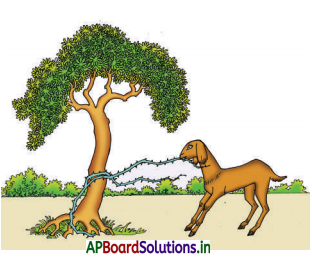
జవాబు:
గాలి : నువ్వు చాలా మారిపోయావు
మేక : అవును ఇకనుండి మనం స్నేహితులం
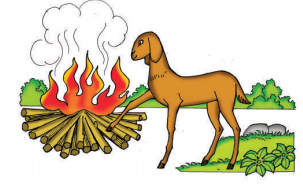
జవాబు:
నిప్పు : నువ్వు చాలా మారిపోయావు
మేక : అవును ఇకనుండి మనం స్నేహితులం
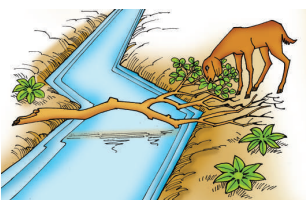
జవాబు:
ఏరు : నువ్వు చాలా మారిపోయావు
మేక : అవును ఇకనుండి మనం స్నేహితులం
ప్రశంస
మీ ఇంటికి వచ్చిన స్నేహితులను మీరు ఎట్లా గౌరవిస్తారో చెప్పండి.
జవాబు:
ముందుగా సాదరంగా ప్రేమతో లోపలకి ఆహ్వానిస్తాను. కుర్చీలు చూపించి కూర్చోమంటాను. త్రాగటానికి మంచినీరు ఇస్తాను. వాళ్ళ రాకకు కారణం తెలుసుకుని వారితో చక్కటి సంభాషణ చేస్తాను. వారు నానుండి కోరుకుంటున్న విషయానికి సాయం చేస్తాను.
![]()
వారు వచ్చిన సమయాన్ని బట్టి అల్పాహారానికి గాని, భోజనానికి గాని, ఆహ్వానించి అమ్మ చేసిన రుచికర మిఠాయిలను గాని తినిపిస్తాను. వారిపట్ల ఈ విధంగా స్నేహ పూరిత గౌరవాన్ని చూపిస్తాను.
ప్రాజెక్టుపని
ఏవైనా జంతువుల కథలను సేకరించి మీ తరగతిలో ప్రదర్శించండి.
జవాబు:
విద్యార్థి కృత్యము.
భాషాంశాలు
అ) కింది వాక్యాలు చదవండి. గీత గీసిన పదాలు గమనించండి.
- విజయ్ తెలివైన బాలుడు
అతడు మూడవ తరగతి చదువుతున్నాడు.
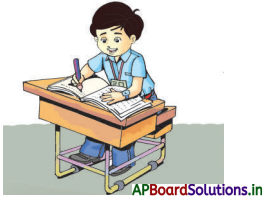
మొదటి వాక్యంలో ‘విజయ్’ నామవాచక పదం కదా! రెండవ వాక్యంలో ‘అతను’ అనే పదాన్ని ‘విజయ్’కి బదులుగా వాడారు. ఇలా నామవాచకాలకు బదులుగా వాడే పదాలను సర్వనామాలు’ అంటారు.
అతడు, ఆమె. అది, మేము, నేను, వారు, వీరు మొదలైనవి “సర్వనామాలు”
ఆ) కింది పట్టికలోని సర్వనామాలను గుర్తించి రాయండి.
లత, అతను, ఆమె, వీరు, రాజు, చిలుక, అది, చెట్టు, వారు, ఇతను, మేము, వనజ, బడి, నేను, నీవు మనం
ఉదా : మనం
జవాబు:
- అతను
- ఆమె
- వీరు
- అది
- వారు
- ఇతను
- మేము
- నేను
- నీవు
![]()
ఆ) కింది సర్వనామాలను గమనించండి.
నేను – మేము/మనం
నీవు – మీరు
వాడు/ఆమె – వారు/వాళ్లు
వీడు/ఈమె – వీరు/వాళ్లు
అది – అవి
ఇది – ఇవి
జవాబు:
ఏక వచనం – బహువచనం
నేను – మేము/మనం
నీవు – మీరు
వాడు/ఆమె – వారు/వాళ్లు
వీడు/ఈమె – వీరు/వాళ్లు
అది – అవి
ఇది – ఇవి
కవి పరిచయం
చందమామ కథలు
1949లో బాపట్లకు చెందిన ఆర్. శకుంతల రచించిన చందమామ కథ

పదాలు – అర్థాలు
బుద్ధి = ఆలోచన
వాలకం = తీరు
గందరగోళం = తికమక
అదృశ్యం = మాయం
పొగరు = గర్వం
తిన్నగ = నేరుగా
మరగడం = కాగడం
కాగు = పెద్ద బిందె
![]()
ఈ మాసపు పాట
తెలుగు తోట
పల్లవి :
ఎంత చక్కనిదోయి ఈ తెలుగు తోట
ఎంత పరిమళమోయి ఈ తోట పూలు
|| ఎంత ॥
చరణం :
ఏ నందనమునుండి ఈ నారు తెచ్చిరో
ఏ స్వర్ణనదీజలము ఈ మడుల కెత్తిరో
ఎంత వింతల జాతులీ తోటలో పెరుగు
ఈ తోట ఏపులో ఇంత నవకము విరియ
||ఎంత ||
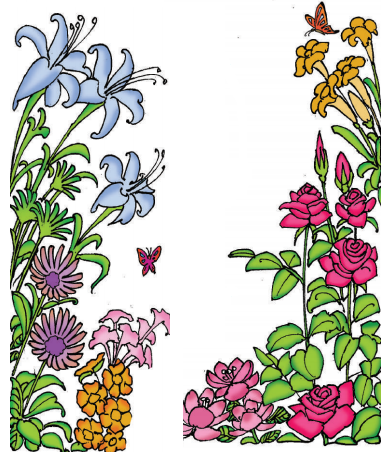
చరణం:
ఏ అమృత హస్తాల ఏసురలు తాకిరో
ఏ అచ్చెరల మరుపులితీరు దిద్దిరో
ఈ పూల తీరులో ఇంత తీయందనము
ఈ లతల పోకళ్ళ కింత వయ్యారము
|| ఎంత ||
కవి పరిచయం
కవి : కందుకూరి రామభద్రరావు
కాలము : (31-1-1905 – 8-10-1976)
రచనలు : ‘లెమొగ్గ’, ‘తరంగిణి’, ‘గేయమంజరి’
విశేషాలు : కందుకూరి రామభద్రరావు కవి, విద్యావేత్త,

ఈ మాసపు కథ
మేకపోతు గాంభీర్యం
ఒక రోజు ఒక మేక మంద నుండి తప్పిపోయింది. ఇంటిదారి కోసం వెతుకుతూ.. అడివిలోపలికి వెళ్లి పోయింది. చీకటి పడింది. కాని ఇంటికి వెళ్ళే మార్గం కనిపించలేదు. ఏం చేయాలో పాలుపోక అటూ… ఇటూ తిరుగుతున్న దానికి ఒక రాతి గుహ కనిపించింది. అ గుహ లోపలికి వెళ్ళి పడుకుంది.
కొంత సమయం గడిచాక సింహం అక్కడికి వచ్చింది. అ గుహ సింహానిదే . లోపలికి వెళ్ళబోయిన సింహానికి ఆ చికట్లో మిలమిలా మెరుస్తున్న మేక కళ్ళు కనిపించాయి. దాంతో భయపడింది సింహం. లోపలికి వెళ్ళకుండా ఆ రాత్రంతా బయటే కూర్చుంది.
![]()
సింహం జాడ పసికట్టిన మేకపోతు కూడా భయంతో గడగడ వణికిపోయింది. ‘ అమ్మో ఇది సింహం గుహా? తెలీక వచ్చి చిక్కుకుపోయాను. దాని కంట్లో పడితే ఇంకేమైనా వుందా! గుటుక్కున మింగేయదూ.. ఎలా ఆపద నుండి గట్టేక్కేది’ అనుకుని వున్న చోటే కూలబడి పోయింది మేకపోతు.
తెల్లవారింది. మేకపోతు దడదడలాడే గుండెను చిక్కబట్టుకుంది. పైకి మాత్రం ధైర్యం ప్రదర్శిస్తూ గుహబయటకు వచ్చింది. ” ఏయ్ ఎవర్నువ్వు? ” సింహాన్ని గద్దించి అడిగింది. ఆ గద్దింపు వినగానే సింహం భయంగా ” అయ్యా నేను ఈ అడివికి రాజుని. తమరెవరు?” అంది.
” నా గురించి నీవు వినలేదా? ఇప్పటి వరకు నేను తోంభై తొమ్మిది సింహాలను చంపి తిన్నాను. నూరు సింహాలను చంపితే కాని నా గెడ్డం తీయనని వ్రతం పట్టాను. నీకోసమే ఎదురు చూస్తు నీ గుహలోనే మాటు వేసాను. నిన్ను చంపితే నా వ్రతం పూర్తవుతుంది” అని మేకపోతు గంభీరంగా అంది.
అంతేకాదు రెండు కాళ్ళు పైకెత్తి సింహం మీదకు దూకడానికి సిద్ధం అయింది. మేకపోతు మాటలు నమ్మిన సింహం భయపడి అక్కడి నుండి పారిపోయింది. ఈ విధంగా ఉపాయంతో అపాయాన్ని తప్పించుకుంది మేకపోతు.
